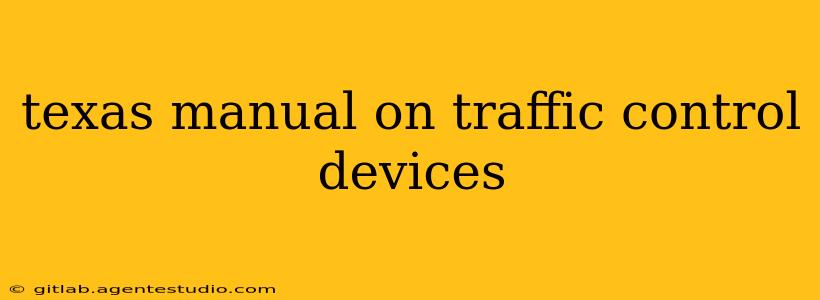The Texas Manual on Uniform Traffic Control Devices (TMUTCD) serves as the definitive guide for traffic control within the state of Texas. This comprehensive manual dictates the standards, specifications, and application of all traffic control devices, ensuring consistency and safety across Texas roadways. Understanding its contents is crucial for engineers, contractors, law enforcement, and anyone involved in managing or interacting with Texas roads.
What is the TMUTCD and Why is it Important?
The TMUTCD, much like its national counterpart (MUTCD), aims to establish uniformity in traffic control. This uniformity is essential for several reasons:
- Improved Safety: Consistent signage, pavement markings, and traffic signals minimize confusion for drivers, pedestrians, and cyclists, thereby reducing accidents.
- Efficient Traffic Flow: Properly placed and designed devices optimize traffic movement, minimizing congestion and delays.
- Legal Compliance: Adherence to the TMUTCD is often a legal requirement for projects involving roadway alterations or new installations. Failure to comply can lead to legal repercussions.
- Cost Savings: Using standardized devices and methods reduces material costs and simplifies installation and maintenance.
Key Components of the TMUTCD
The TMUTCD covers a vast array of traffic control elements, including but not limited to:
1. Signs:
- Regulatory Signs: These signs dictate legal requirements, such as speed limits, stop signs, and no-parking zones. The TMUTCD specifies the design, placement, and wording for these signs.
- Warning Signs: These alert drivers to potential hazards ahead, such as curves, intersections, and school zones. The manual details the appropriate symbol, message, and placement for effective warning.
- Guide Signs: These provide information to drivers, such as route numbers, destination distances, and points of interest. The TMUTCD standardizes their design and placement for optimal readability.
2. Pavement Markings:
- Lines: The TMUTCD outlines the types of lines (solid, dashed, broken), their widths, and their application in various traffic situations.
- Symbols: These painted symbols, such as arrows and crosswalks, provide visual guidance to drivers and pedestrians. The manual specifies their design and appropriate placement.
3. Traffic Signals:
- Signal Head Design: The TMUTCD dictates the colors, placement, and sequencing of traffic signals to ensure consistent understanding.
- Signal Timing: The manual provides guidelines for optimizing signal timing to improve traffic flow and reduce delays.
4. Other Devices:
The TMUTCD also addresses other traffic control devices, such as:
- Rumble Strips: Used to alert drivers of lane departures or approaching hazards.
- Traffic Barriers: Used to separate traffic flows or protect vulnerable areas.
- Work Zone Traffic Control: Specific guidelines for managing traffic during construction or maintenance activities.
Accessing and Understanding the TMUTCD
The Texas Department of Transportation (TxDOT) is the primary source for the TMUTCD. While the complete manual might be extensive, relevant sections can usually be located through TxDOT’s website, focusing on specific needs or projects. Understanding the relevant sections is key to ensuring compliance and safety. It's often advisable to consult with traffic engineering professionals for complex projects or situations.
Conclusion: The Importance of Compliance
Compliance with the TMUTCD is not merely a matter of following rules; it's a crucial element in ensuring the safety and efficiency of Texas roadways. By understanding and applying the principles outlined in the manual, we contribute to a safer and more smoothly functioning transportation system for everyone. Staying informed about updates and revisions to the TMUTCD is also essential for continuous improvement and compliance.

